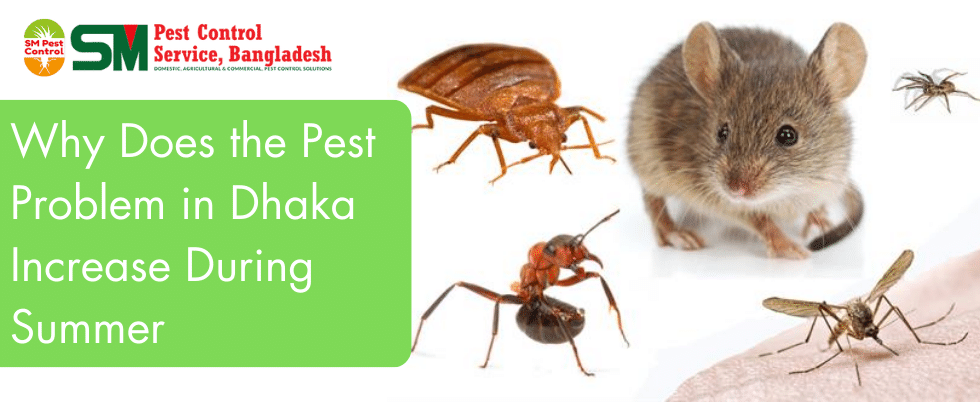In summer Pest problem in dhaka increases a lot. The sweltering summer months in Dhaka bring heat and humidity and an unwelcome surge in pest populations. From mosquitoes to rodents, these uninvited guests can make life uncomfortable for the city’s residents. This comprehensive blog post will delve into the factors behind this seasonal increase in pest problems and provide insight into the challenges of managing these infestations in Dhaka.
High Temperature and Humidity: A Perfect Breeding Ground
Faster Pest Reproduction Rates
High temperatures and humidity during the summer months in Dhaka accelerate the reproductive cycles of many pests, including mosquitoes and cockroaches. This leads to a rapid increase in their populations, creating a persistent nuisance for residents.
Increased Pest Activity
Pests, like most living organisms, are more active in warmer temperatures. The summer heat in Dhaka encourages pests such as ants and rodents to forage for food and water, often leading them to enter homes and other buildings in search of sustenance.
Higher Pest Survival Rates
The warm, humid conditions of Dhaka’s summer are conducive to the survival of many pests. For example, mosquito larvae require standing water and high humidity levels to develop into adults, making Dhaka’s summer climate particularly favorable for their growth.
Summer Monsoons: Water, Water Everywhere
Standing Water: A Mosquito’s Paradise
Dhaka’s summer monsoons lead to an abundance of standing water, which is essential for mosquito breeding. Stagnant water in puddles, containers, and clogged drains provides ideal conditions for mosquitoes to lay their eggs and multiply rapidly.
Damp Conditions: A Haven for Cockroaches and Mold
The high humidity and dampness associated with the monsoon season create a hospitable environment for cockroaches and mould growth. These conditions encourage cockroach infestations in homes and buildings as they seek out dark, damp places to nest.
Flooding: Displacement of Rodents and Other Pests
Flooding caused by heavy rains during the monsoon season can displace rodents, ants, and other pests from their usual habitats, forcing them to seek shelter in homes and other structures. This increases the likelihood of pest infestations in residential areas.
Urbanization and Population Growth: Stress on Infrastructure
Inadequate Sanitation and Waste Management
The rapid urbanization and population growth in Dhaka has put tremendous pressure on the city’s sanitation and waste management systems. The accumulation of garbage and poor sanitation practices create favourable conditions for pests to thrive.
Construction and Building Maintenance Challenges
The city’s rapid expansion has led to numerous construction projects, which can disrupt the habitats of pests like rodents and insects, driving them into nearby homes and buildings. Additionally, inadequate building maintenance practices, such as failing to seal cracks and repair leaks, create entry points and nesting spots for pests.
Overcrowding and Limited Green Spaces
The increasing population density in Dhaka has led to overcrowded living conditions and reduced green spaces. This limits the natural predators of pests, such as birds and spiders, resulting in unchecked growth of pest populations.
Limited Public Awareness and Pest Control Resources
Insufficient Public Knowledge of Pest Prevention
Many Dhaka residents may need to be made aware of the best practices for preventing pest infestations in their homes and surroundings. This lack of knowledge can result in ineffective pest control measures, allowing pest populations to flourish.
Inadequate Pest Control Infrastructure
Dhaka’s rapid growth and dense population can make it challenging for the city’s pest control infrastructure to keep pace with the increasing pest problem. Limited resources and human resources may result in slower response times and less effective pest management strategies.
Reliance on DIY Pest Control Methods
Without professional pest control services in bangladesh or due to financial constraints, many residents in Dhaka may resort to do-it-yourself pest control methods. While some of these methods can be helpful, they may only sometimes be as effective as professional treatments, leading to a persistent pest problem.
Understanding the factors contributing to the increase in pest problems during Dhaka’s summer months is crucial for developing effective pest management strategies. By addressing issues such as urbanization, infrastructure, public awareness, and pest control resources, the city can work towards a more effective and sustainable solution to its seasonal pest challenges.
If you need pest control service in dhaka feel free and call SM pest control services.

